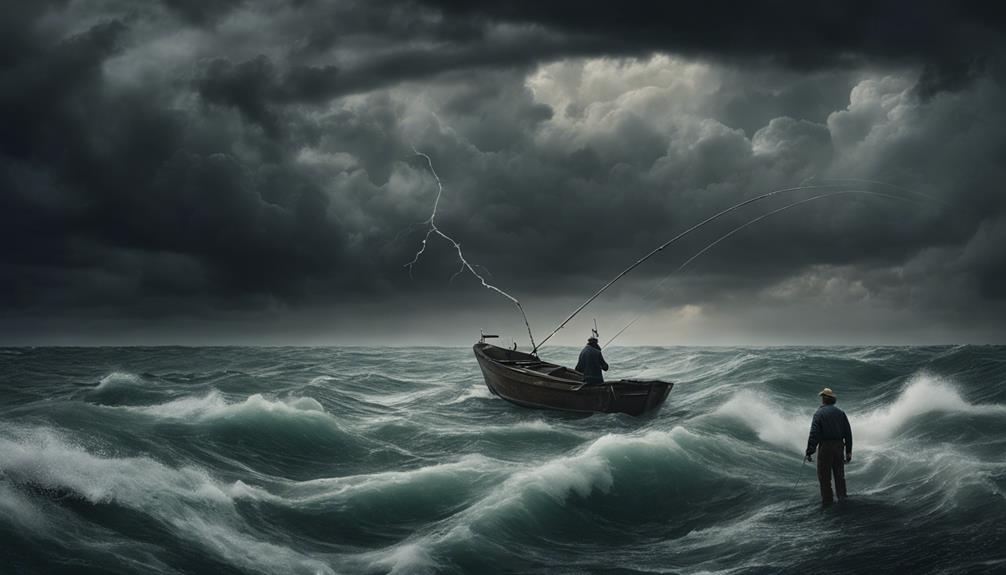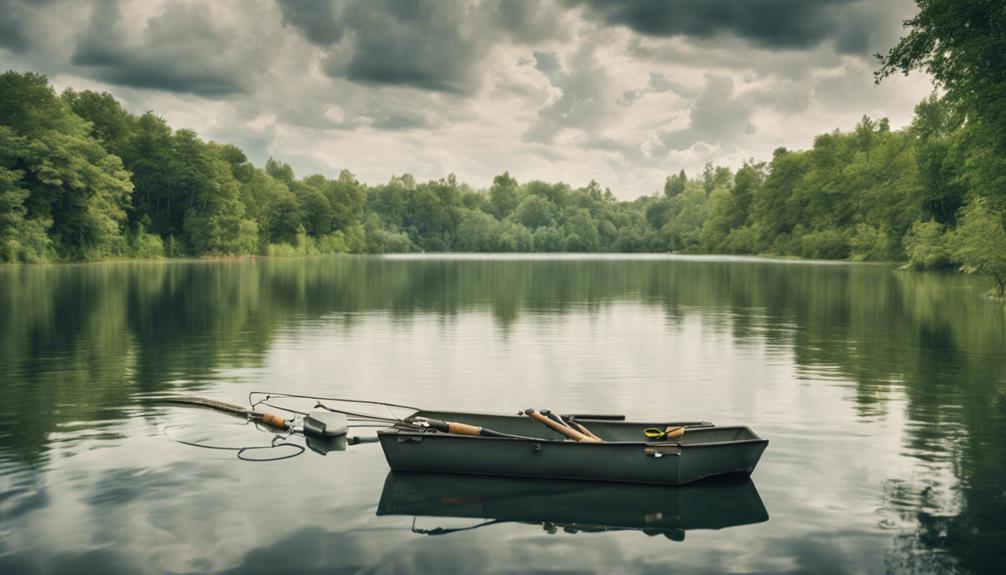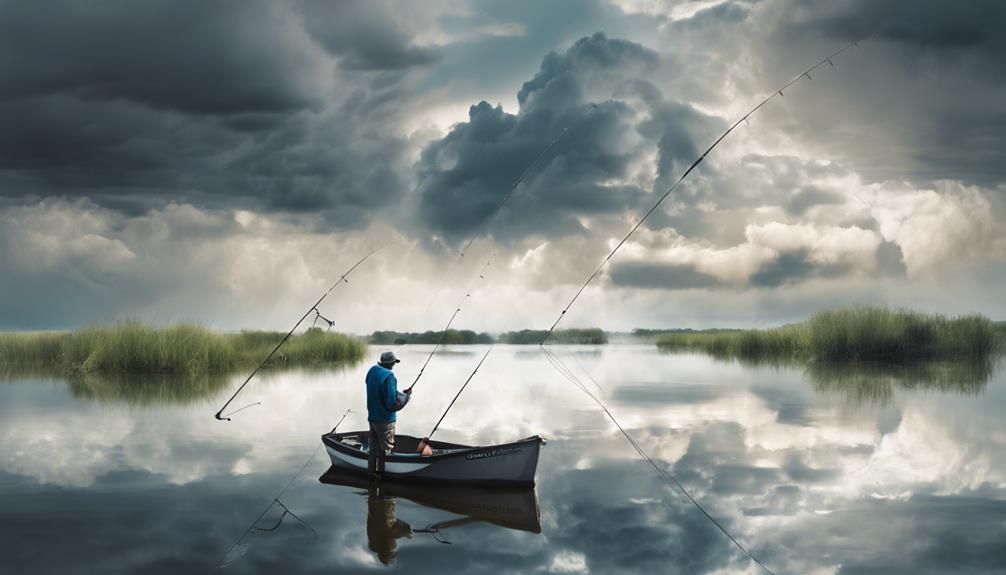During stormy weather, fishing experiences significant shifts in fish behavior. Fish show increased activity due to changes in pressure, temperature, and light. Adapting your techniques to capitalize on this activity can boost your success. Fish alter their feeding patterns, becoming opportunistic feeders, targeting smaller prey, and feeding more frequently but briefly during storms. Knowing this helps you adjust your strategies for better catches. Fish also shift locations, seeking shelter near structures or moving to deeper waters for stability. Understanding these changes can help you adapt effectively. Using different bait types, such as live bait, is crucial during storms. Safety precautions are essential too.
Increased Fish Activity
During stormy weather, fish tend to exhibit heightened activity levels in response to changing environmental conditions. Weather conditions play a crucial role in determining fishing success, as fish react to shifts in barometric pressure, water temperature, and light penetration. When a storm approaches, barometric pressure decreases, signaling to fish that changes are imminent. This drop in pressure triggers fish to increase their activity levels in search of food sources or to seek shelter in preparation for the oncoming storm.
Research shows a direct correlation between stormy weather and increased fishing success. Anglers often report better catches during or just before a storm, as fish become more active and aggressive in their feeding behaviors. The turbulent conditions caused by a storm can disorient prey fish, making them more vulnerable to predators. This presents an opportunity for anglers to capitalize on the heightened activity levels of game fish that are actively hunting under these conditions.
Understanding the relationship between weather patterns and fish behavior is essential for maximizing fishing success during stormy weather. By monitoring weather forecasts and adapting fishing techniques to capitalize on increased fish activity, anglers can significantly improve their chances of a successful catch. Remember, the next time a storm rolls in, don't be deterred—instead, take advantage of the heightened activity levels of fish to reel in that prized catch.
Change in Feeding Patterns
The heightened activity levels of fish during stormy weather lead to significant changes in their feeding patterns, impacting fishing success. Behavioral shifts play a crucial role in how fish behave when a storm approaches. Studies have shown that fish tend to increase their feeding activity prior to a storm as they sense the drop in barometric pressure. This behavior is linked to their instinct to feed more before a potential period of reduced feeding opportunities during the storm.
Feeding behavior during stormy weather is characterized by a higher frequency of feeding events but with shorter durations. Fish become more opportunistic feeders, actively seeking out food sources to build up their energy reserves. This increased feeding activity is driven by the need to prepare for the potential scarcity of food during and after the storm.
Additionally, the types of prey fish target can also change during stormy weather. They may shift their focus to smaller, more abundant prey that are easier to catch in turbulent waters. This adaptation in feeding behavior allows fish to maximize their feeding efficiency and intake, ultimately influencing fishing outcomes during stormy conditions. Understanding these behavioral shifts in feeding patterns can help anglers adjust their strategies to capitalize on the changes fish exhibit during stormy weather.
Shift in Fish Locations
Experiencing stormy weather prompts fish to relocate in search of calmer and more sheltered areas for increased safety and comfort. This shift in fish locations can significantly impact angler strategy and success rates. Understanding how fish behavior changes during stormy weather is crucial for adapting your fishing techniques effectively.
- Seeking Shelter: Fish tend to move towards structures such as rocks, fallen trees, or underwater ledges to find refuge from turbulent waters.
- Deeper Waters: During stormy weather, fish often move to deeper parts of the water where they can find more stability and avoid strong surface currents.
- Near Vegetation: Vegetated areas provide fish with protection from the elements and potential food sources, making them attractive locations for fishing during storms.
- Change in Currents: Storms can alter water currents, causing fish to relocate to areas where the flow is less intense, such as eddies or areas shielded by land formations.
Use of Different Bait
When faced with stormy weather conditions, anglers may find it beneficial to consider using different bait types to effectively target relocated fish populations. Bait selection plays a crucial role in enticing fish during adverse weather conditions. Stormy days can disrupt the natural feeding patterns of fish, causing them to seek shelter or move to different areas. To adapt to these changes, anglers should adjust their bait choices to match the altered behavior of the fish.
During stormy weather, fish are often more reluctant to feed on traditional bait options. This shift in feeding behavior requires anglers to experiment with various bait types to find what works best. Live bait such as minnows, worms, or shrimp can be particularly effective during stormy days as they emit natural scents that can attract fish despite the challenging conditions. Additionally, artificial baits like soft plastics or lures that mimic injured or struggling prey may also prove successful in triggering strikes from fish that are less active due to the weather.
Incorporating different fishing techniques alongside varied bait choices can further increase the chances of a successful catch during stormy weather. By understanding the impact of weather conditions on fish behavior and adapting bait selection accordingly, anglers can optimize their fishing strategies for greater success even when faced with challenging stormy conditions.
Safety Precautions
Considering the potential risks associated with fishing in stormy weather, implementing safety precautions is imperative to safeguard both yourself and your equipment. When heading out into stormy conditions, it's crucial to have emergency plans and preparations in place to mitigate any unforeseen dangers. Here are some key safety measures to follow:
- Emergency Plans: Before setting out, ensure you have a well-thought-out emergency plan in case the weather worsens unexpectedly. This plan should include details on how to safely navigate back to shore or seek help if needed.
- Preparation: Check and double-check all your safety equipment, such as life jackets, emergency flares, and a first aid kit. Making sure everything is in good working condition can make a significant difference in case of an emergency.
- Weather Monitoring: Stay updated on weather forecasts and any storm alerts in your area. Technology has made it easier than ever to access real-time weather information, so take advantage of this to make informed decisions about your fishing trip.
- Updates: Continuously monitor weather updates while you're out on the water. Storms can develop rapidly, so staying informed can help you avoid potentially dangerous situations.
Frequently Asked Questions
Can Stormy Weather Affect the Size of the Fish Caught?
During stormy weather, fish size can indeed be affected. The turbulent conditions can impact the behavior and feeding patterns of fish, leading to variations in the sizes of fish caught.
Catch rates may also fluctuate due to the changes in fish movement and activity caused by the storm. Understanding these dynamics can help anglers adapt their strategies to optimize their fishing success during stormy weather conditions.
Will Fish Behavior Change During Different Types of Storms?
During different types of storms, fish behavior can be influenced by tidal patterns and barometric pressure.
Tidal patterns may affect where fish congregate, while changes in barometric pressure can impact their feeding habits.
Understanding these factors can help you anticipate how fish will react to stormy weather conditions and adjust your fishing strategies accordingly.
How Do Stormy Conditions Impact the Choice of Fishing Technique?
When fishing in stormy conditions, your tackle selection becomes crucial. Opt for heavier gear to handle the rough waters and strong winds.
Focus on improving your casting accuracy to reach your targets effectively. Adjust your bait presentation to entice fish in murky waters.
Maintain good line control to prevent tangles in the wind. These strategic adjustments will help you adapt to stormy weather and increase your chances of a successful catch.
Are Certain Fish Species More Active During Storms?
During storms, some fish species become more active due to fish migration patterns and changes in water clarity. The disturbance in the environment can trigger certain species to move to shallower areas or become more aggressive in their feeding behaviors.
Fish like bass and catfish are known to be more active during stormy weather, taking advantage of the conditions to hunt for prey more efficiently. This behavior is influenced by the instinctual responses of these species to changing environmental factors.
What Should Anglers Do if Caught in a Sudden Storm While Fishing?
When caught in a sudden storm while fishing, prioritize safety precautions. Seek shelter in emergency shelters if available. Avoid open water and head towards shore.
Stay calm and assess the situation. Secure loose items and equipment to prevent accidents. Follow weather updates and wait for the storm to pass before considering resuming fishing activities.
Your safety is paramount in such situations, so take necessary precautions to ensure a smooth and secure experience.
Conclusion
In conclusion, stormy weather can greatly influence fishing outcomes through increased fish activity, changes in feeding patterns, shifts in fish locations, and the use of different bait.
By understanding these factors and taking appropriate safety precautions, anglers can adapt their strategies to maximize their chances of success during inclement weather conditions.
With careful observation and adjustment, anglers can continue to enjoy productive fishing trips even when faced with stormy weather.



